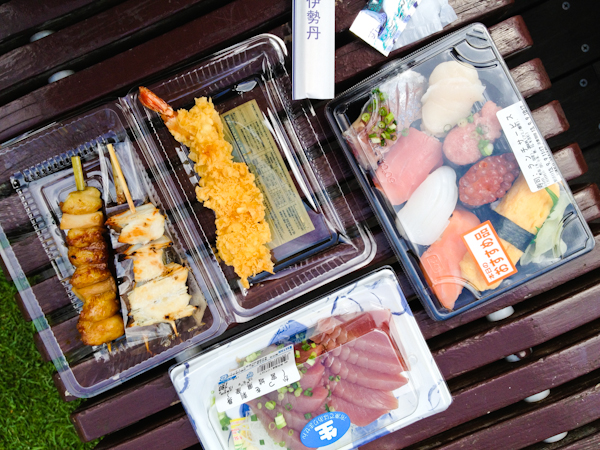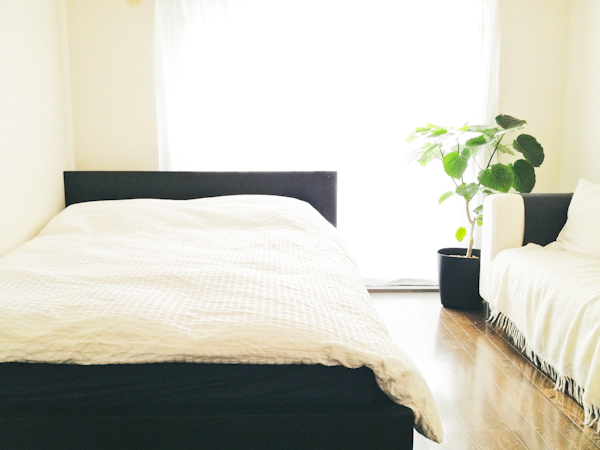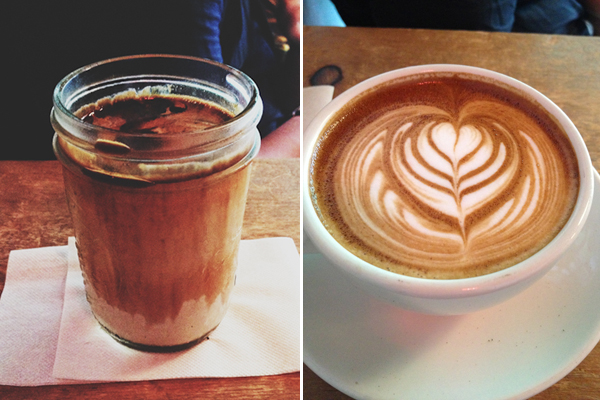Last September, we took a short trip to Tokyo. It was my first time in Japan, and though my husband has relatives there, he hadn’t been back since childhood. This city truly felt like Paris in Asia, and like the French, the Japanese also bring a lot of care and attention to everything they do. Ever since our trip, I have found myself quite smitten with the Japanese obsession with details and their compulsion to perfect absolutely everything, right down to how to keep your noodles firm when you are eating them with broth. These are the questions that keep this culture up at night. And we were very happy to benefit from it for a brief four days.
During our time in Tokyo, we stayed in a neighborhood called Shimokitazawa on the western edge of the city. The area’s calm, relaxed pace was just right for us with our two-year-old, but at the same time, the long history of arts and culture there has exploded into a hip, vibrant community kept alive by both young and old. Our kind AirBnB hostess, Wakana, gave us such a great introduction to the area that I ended up writing a travel piece on our time there. The story ran recently in the Washington Post travel section, and if you’re interested you can read more about the neighborhood’s personality, history, and offerings there. Tokyo is pretty expensive, so if you’re ever looking for a more affordable lodging option, Shimokita is definitely a great pick, especially if you also want to get away from the frenzy of the big city!
Much or our time in between meals in Tokyo was spent meandering in different neighborhoods and popping in and out of shops. We’re lucky to have plenty of Uniqlo and Muji shops in Beijing, so in Tokyo we instead frequented Tokyu Hands, Loft, and Daiso. Our hostess also kindly invited us over to her home and to attend the annual local temple festival with her family, which we thoroughly enjoyed. It really gave us such a personal glimpse into local life and culture. One morning, we even stumbled upon this children’s parade coinciding with the festival, and little E was very happy to participate in it!
As for food, given that our time in Tokyo was very brief, we decided to focus on just a few things we really wanted to eat…
Sushi
I am just going to have to write a separate post on this, because there is too much to say about sushi in Tokyo! Stay tuned to find out where my husband and I ended up going for sushi, with toddler in tow.
Ramen
Like sushi, ramen really belongs in its own food category, and as I tried to learn more about it before our trip, I was completely overwhelmed by all the different types of ramen that exist, as well as by all the reverence and devotion to this food. There are so many food blogs out there focused solely on ramen in Japan. The most helpful primers I found were Ramen Adventures’ post on Best of the Best, which is a succinct summary of ramen styles and a couple suggestions of the best places to sample them; and Lucky Peach magazine’s launch issue devoted to ramen, including a feature on the regional ramen styles throughout Japan. I had a long list of ramen places I was interested in, and I knew we would only get to a few, but I always like to have a lot of options ready to make use of opportunities if we happen to be nearby.
Our first meal in Tokyo was at Bassanova out near Shimokita. This place is unique in that, in addition to serving regular ramen, they also have a few Thai fusion ramen options, since one of the early chefs was from Thailand. Their most popular bowl is the Thai green curry ramen, which I ordered tsukemen style, where the broth is served separately and you dip the noodles in. This was some of the best ramen I’ve ever had, with the firm, thick noodles I prefer. The green curry broth was a perfectly balanced blend of tonkotsu broth, coconut milk, and Thai herbs and spices. I think because it was served tsukemen or dipping style, the broth was concentrated and quite intense, almost sauce-like. I’ve heard they also do a tom yum curry, which I must have missed but would’ve loved to try. If you’re curious but can’t make it to Japan anytime soon, Bassanova has also opened a New York branch!
We also got the tondatsu wadame soba, another of their popular bowls. This one was more of a typical Japanese ramen but also very well done.
Bassanova, 1-4-18 Hanegi, Setagaya-ku; +81 (0) 3 3327 4649; open M-F 5pm-2am, Sat-Sun noon-2am. [map]
The other ramen place we tried is a staple in Japan: Ichiran. This chain has locations in many cities in Japan and is distinctive for, first, its single focus on Hakata-style tonkotsu ramen (with the pork bone broth), and second, for its unique, quirky restaurant format. There are only individual booth-style seats at Ichiran, and I must admit this instantly appealed to me as an introvert, because you essentially don’t have to see or talk to a single soul during your entire time there. You fill out your order on the minimal menu (while they only serve tonkotsu ramen, you can specify details like firmness of noodles and extras like an egg on the side) and then hand it to a waiter who appears only as an aproned waist through the narrow window of your booth. After your order arrives, they pull down a curtain so you can eat in peace and solitude. You even have your own water spout so you can pour and refill your own water. Now that’s my kind of place! :)
Format aside, I should also mention Ichiran serves a solid bowl of tonkotsu ramen. :)
 Ichiran, locations throughout Tokyo and Japan (see website for details)
Ichiran, locations throughout Tokyo and Japan (see website for details)
Although we only made it to two ramen places in Tokyo, I have to say that ramen has not been the same for me since. I’ve tried to satisfy ramen cravings at places around Beijing (Ippudo even recently opened here) and even in Portland, but nothing tastes the same as the ramen we had in Tokyo. Sigh! I particularly love how fresh the noodles are in Japan and how you always get to specify your noodle firmness. Although, living in Beijing we do get plenty of excellent fresh hand-pulled noodles served Chinese style, so I really can’t complain!
FYI, here are a few other ramen places I really wanted to try in Tokyo: tsukemen ramen at Rokurinsha, Tetsu, and Suzuran, and Ivan Ramen (shio- and shoyu-style ramen by a New Yorker; this place also has a New York branch).
Izakaya
A couple of izakayas came highly recommended to us by friends, so we knew we had to try them. Izakayas are Japanese gastropubs, and even though that may sound quite pedestrian, like all things in Japan, anything can turn out exquisite with that Japanese touch. Some people think izakayas are the next Japanese food craze.
Teyandei was spoken very highly of by my husband’s friend and colleague who had been working in Tokyo for the past few years. The restaurant is converted from an old house in the backstreets of the Roppongi area, so the building is pretty spacious by Tokyo standards. (I was a bit wary of bringing a toddler into tiny, cramped Tokyo joints, so this was a relief to me.) There was also an English menu, which was helpful in figuring out a range of things to order.
One of our favorites, which the waiter recommended, was a dish of Japanese yam fried to a perfect crisp and served with an incredible housemade tartar sauce (see top left in above photo). We also got a few other small plates, including (clockwise from top right) some excellent grilled chicken with scallions, a seafood pasta in white sauce (the details of which I’ve forgotten – sorry), and eel wrapped in omelet. The waiter also recommended the braised pork belly with a soft potato puree (below), and we tried some sake, which is always poured to overflowing according to Japanese hospitality.
I had mistakenly thought the pasta dishes were small portioned, which is how we ended up with two pastas (though our toddler was happy to eat these). But this uni carbonara below was definitely a highlight. It was mixed and served tableside and was quite a lovely little show.
Teyandei, 2-20-1 Nishiazabu, Minato-ku, Minato; 03-3407-8127. [map]
See website for other locations in Tokyo. Reservations recommended.
The second place, Uoshin, is a neighborhood izakaya with several locations and was recommended by our AirBnB hostess, Wakana. The branch we went to in Shimokita seemed more elegant than some of the other locations described as informal-feeling fish shacks. This place is known for fish and seafood, so that is what we focused on. Although, since the location we went to didn’t have an English menu, it was hard for us to determine what to get, so we just went with some of the waiter’s suggestions. This included a sashimi plate full of really fresh selections:
We also got a grilled fish and a side dish of fried shredded potato, which reminded me of the Hickory Sticks of my childhood and were quite addictive. These ones being much lighter and more delicate, though. :)
Uoshin, 2-1-1 Kitazawa, Setagaya; +81 3 3419 5584. [map]
The main location is in central Tokyo and is more like a casual fish shack: 9-6-32 Akasaka, Minato-ku; +81 (0) 3 3405 0411. [map]
Depachika
I’ve heard many great things about the gourmet food halls in Japanese department stores or depachika. It’s one of the best places to go with children, as there are some really good restaurants there that are more kid-friendly, as well as huge, elaborate gourmet markets in the basements, with aisles and aisles of gleaming, beautiful food. I wish I had gotten a panoramic photo of it! But instead, I offer you this photo of macarons from Patisserie Sadaharu Aoki, where I attempted yet again to become a fan of macarons (still haven’t succeeded yet, but I did find the yuzu, wasabi, and salted caramel flavors ranging from interesting to enjoyable).
The depachika we went to was the Istean flagship in Shinjuku, which is often said to be one of the best department stores. After a very long time perusing the food hall and supermarket and trying to make up our minds what to get, we finally gathered our items and headed upstairs for a picnic in the rooftop garden. Just look at this place!
This was definitely one of the highlights of our trip. Little E could not get enough of the slides and running around on the grass chasing dragonflies. Coming from polluted, grimy Beijing, we felt like we were in heaven.

Isetan, 3-14-1 Shinjuku Shinjuku-ku, Tokyo, gourmet food hall in basement level B1F. [map]
Coffee
While coffee doesn’t seem like the obvious beverage to consume in Japan, like so many of the other foreign imports that the Japanese borrow and then perfect, these days a lot of the high-end coffee gear and brewing techniques in the West are coming from Japan. So I was very curious about the coffee scene in Tokyo, where it is both an old and a new thing.
On the new side, you’ll find trendy Western-style places, like Bear Pond Espresso in Shimokita, which is something of an icon in the coffee world, or so I hear. And they do make some really fine coffee, like this “Dirty” that they are famous for — layers of cold milk and two shots of espresso that naturally swirl together from the way they’re poured into a cold mason jar, creating a smooth, luscious drink. (Apparently the proper way to drink it is as-is; no mixing.)
Unbeknownst to me at the time, Bear Pond is also known for being quite fussy, with all kinds of rules like no espresso after 2pm — and no photos! All I knew during my visit was that they seemed a bit unhappy about us bringing a toddler in and kept telling us not to venture into certain parts of the tiny shop (after all the consideration I put into looking for places to dine in Tokyo that would not be entirely inappropriate with a small child, I have to say it was a little ironic that the only place not pleased about it was this coffee shop!). But what can I say… I guess when you make perfect coffee, you also get to make the rules.
Bear Pond Espresso, 2-36-12 Kitazawa, Setagaya-ku; +81 3-5454-2486; Wed-Mon 10am-6.30pm, Closed Tues. [map]
On the other end of the coffee spectrum, I was very intrigued by historic Japanese kissaten, which are old, dark, moody coffee lounges where people linger, listen to music, and soak in the ambience. I went to Cafe de l’Ambre, whose owner started the coffee shop as a place to show movies because he worked as a movie projectionist after WWII. This place felt something like a bar from another era or a jazz club (this one didn’t have music, but it still had that sophisticated feel and mellow mood).
Cafe de l’Ambre, 8-10-15 Ginza, Chuo-ku; +81 3 3571 1551 Mon-Sat: 12pm-10pm, Sun: 12pm-7pm [map]
So these were the food groups we covered in Tokyo this trip: sushi, ramen, izakaya, depachika, and coffee. I would say the one thing missing for me was yakitori. Of course there are still a lot of other aspects of Japanese food we haven’t yet had a chance to explore, but I think those were the ones we wanted to try most. In fact, we loved our short introduction to Japanese food and culture so much that we’re already planning a trip back — we’re actually heading to Hokkaido and Kyoto next week! I’ll post pictures to Instagram as usual, but in the meantime, I’ll have a few more Tokyo posts scheduled for you before we return.
Resources
- LA Magazine’s “Sushi Etiquette“
- Ramen Adventures‘ primer on the “Best of the Best” ramen in Tokyo. Ramenate and Rameniac are two more blogs devoted solely to ramen.
- Lucky Peach, issue (Ramen), summer 2011
- Food Sake Tokyo – Blog written by a former chef and sommelier married to a fishmonger and former Tsukiji Market buyer. They also offer food tours. I couldn’t order the book (of the same name) in time for our trip and wasn’t able to find it in Tokyo, but the blog itself has a lot of good information.
- Bento.com – Guide to dining in several major Japanese cities.
- Tiny Urban Kitchen – Really extensive coverage of dining in Tokyo (as well as a few other parts of Japan), broken down by category. If you’re looking for high-end sushi, there are quite a few posts on the best restaurants for that in Tokyo.
Lastly, I was forewarned many times about how difficult it is to find locations in Tokyo, even with GPS. One thing I found helpful was getting maps and directions, when available, directly from the websites of places we wanted to go to. I also took the extra step of searching for an image of the building or storefront online and printing that out along with the directions. That way we had the option of recognizing a place visually without necessarily having to nail down the exact address. So as I was documenting our meals in Tokyo, I also tried to remember to get a photo of the front of the restaurants, and I’ll upload these to the corresponding links to Google maps, in case it helps anyone in finding places. We still had to ask around for directions a lot, but having some extra info on hand definitely helped.



































Connect with us